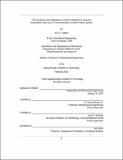The dynamics and regulation of actin filaments in vascular endothelial cells and in a reconstituted purified protein system
Author(s)
Osborn, Eric A. (Eric Alan), 1975-
DownloadFull printable version (1.422Mb)
Other Contributors
Massachusetts Institute of Technology. Dept. of Mechanical Engineering.
Advisor
C. Forbes Dewey, Jr.
Terms of use
Metadata
Show full item recordAbstract
Cell motility and shape change are complex processes that depend primarily on the cytoplasmic dynamics and distribution of actin monomer and polymer. Proteins that regulate actin cycling control cellular architecture and movement. One method to measure parameters that characterize actin dynamics is photo activation of fluorescence (PAF), which can simultaneously estimate the fraction of total actin polymerized (PF) and the lifetime of actin filaments (t). By deciphering the relationships between actin dynamics and regulatory proteins, the complicated motions of cells and biological consequences of these movements can be better understood. In purified actin solutions at steady-state, actin filament dynamics can be analyzed with PAF at long times following photoactivation. By increasing the width of the photoactivated band, actin filament turnover (t ~ 8 hours) can be distinguished from actin filament diffusion. Proteins believed to stabilize actin filaments against depolymerization markedly slow actin filament turnover in wide photoactivated bands (t ~ 65 hours). Decreasing the band width causes photoactivated fluorescence to decay more rapidly (t ~ 3 hours) due to a combination of actin filament diffusion and turnover. Addition of actin binding protein forms crosslinked actin gels that hinder filament diffusion and slow filament turnover (t ~ 12 hours) in narrow photoactivated bands. Endothelial cells decrease t and PF in order to accelerate their migration speed, consistent with mechanisms attributed to ADF/cofilin in vitro. Removal of gelsolin in fibroblasts produces a similar correlation between motility, t, and PF. Consistent with increased actin filament severing, fast-moving endothelial cells have an increased number of short actin filaments and more uncapped barbed ends, but paradoxically bind less cofilin. A mechanism of increasing endothelial cell motility is proposed that relies on actin filament severing to create uncapped pointed ends for ADF/cofilin-mediated depolymerization.
Description
Thesis (S.M.)--Massachusetts Institute of Technology, Dept. of Mechanical Engineering, 2001. Includes bibliographical references. This electronic version was submitted by the student author. The certified thesis is available in the Institute Archives and Special Collections.
Date issued
2001Department
Massachusetts Institute of Technology. Department of Mechanical EngineeringPublisher
Massachusetts Institute of Technology
Keywords
Mechanical Engineering.